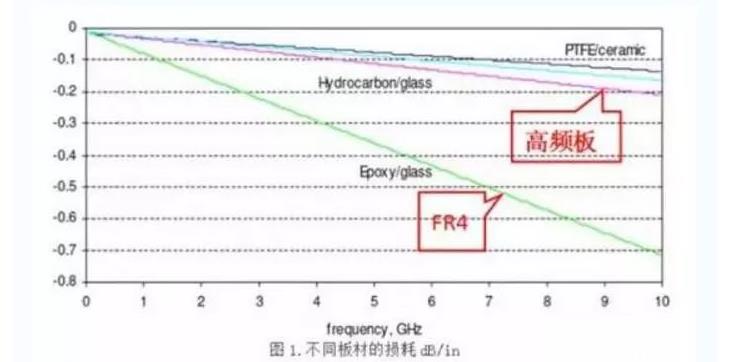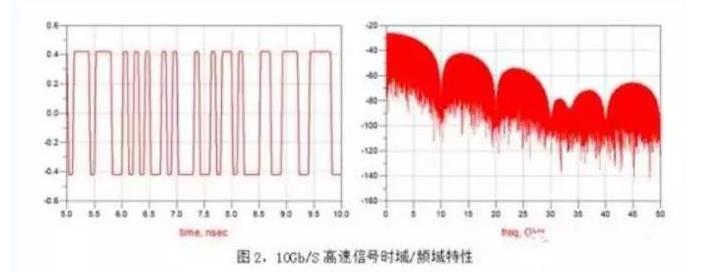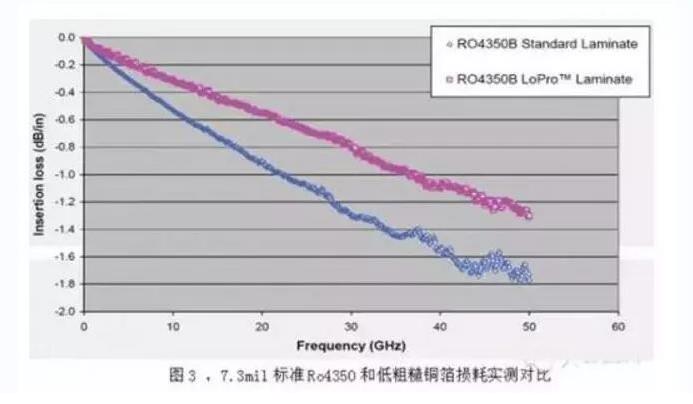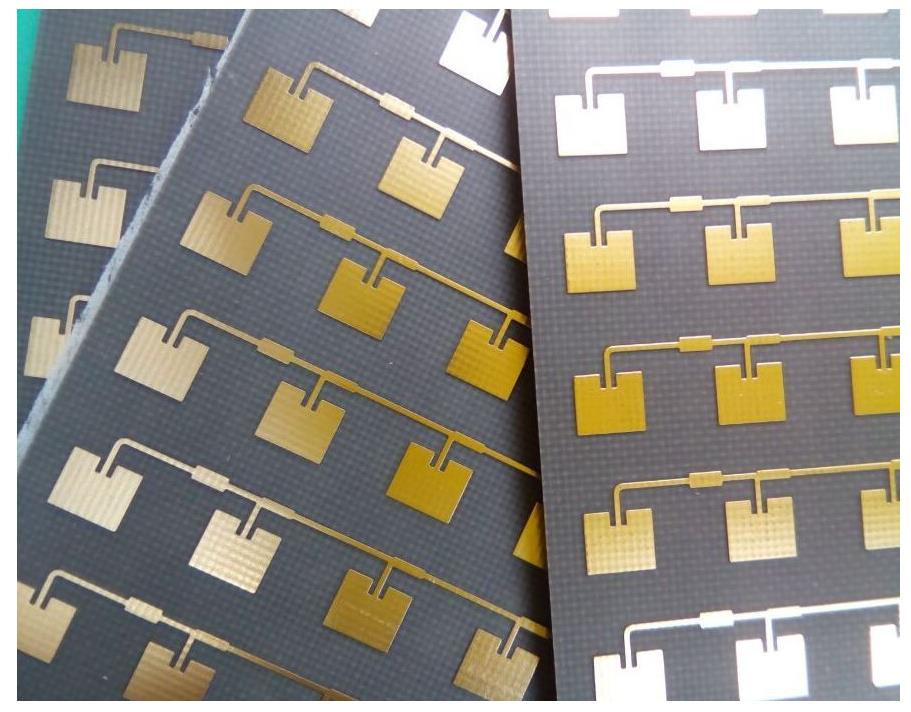Definition of PCB high frequency board
High frequency PCB refers to the special circuit board with high electromagnetic frequency, which is used in the field of high frequency (frequency greater than 300MHz or wavelength less than 1m) and microwave (frequency greater than 3GHz or wavelength less than 0.1M). It is a circuit board produced by using some processes of ordinary rigid circuit board manufacturing method or special treatment method on microwave substrate copper clad laminate. Generally speaking, a high frequency PCB can be defined as a circuit board with a frequency above 1GHz.
With the rapid development of science and technology, more and more equipment are designed for applications above microwave frequency band (> 1GHz) and even millimeter wave field (77GHz) (such as the popular vehicle mounted 77GHz millimeter wave antenna), which also means that the frequency is higher and higher, and the requirements for the substrate of circuit board are higher and higher. For example, the substrate material needs to have excellent electrical properties and good chemical stability. With the increase of power signal frequency, the loss on the substrate is very small, so the importance of high frequency board is highlighted.
Classification of PCB high frequency board:
01. By material
a. Organic materials: phenolic resin, glass fiber / epoxy resin, polyimide, BT / epoxy, etc.
b. Inorganic materials: aluminum, copper invar copper, ceramic, etc. It mainly takes its heat dissipation function.
02. Distinguish between flex and rigid products
a. Rigid PCB
b. Flexible PCB
03. Divided by structure
a. Single sided circuit board
b. Double sided circuit board
c. Multilayer circuit board
04. By purpose
a. Communication
b. Consumable electronics
c. Military
d. Computer
e. Semiconductor test board
Common high-speed board (manufacturer)
01. Rogers
Rogers ro4003, ro3003, ro4350, ro5880, etc
Ro3000 series: PTFE circuit material based on ceramic filling, with models of ro3003, ro3006, ro3010 and ro3035 high frequency laminates.
Rt6000 series: Based on ceramic filled PTFE circuit materials, it is designed for electronic circuits and microwave circuits requiring high dielectric constant. The models are: rt6006, dielectric constant 6.15, rt6010, dielectric constant 10.2
TMM series: Composite materials based on ceramics, hydrocarbons and thermosetting polymers, models: tmm3, tmm4, tmm6, tmm10, tmm10i and tmm13i. wait
02. Taikangli
Taconic TLX series, tly series, etc
03. Panasonic
Panasonic megtron4, megtron6, etc
04, Isola
Fr408hr, is620, is680, etc
05. By purpose
Fr408hr, is620, is680, etc
06, Nelco
N4000-13, n4000-13epsi, etc
07. Taiyao TUC
Tuc862, 872slk, 883, 933, etc
Dongguan Shengyi, Taizhou Wangling, Taixing microwave, Changzhou Zhongying, etc
Of course, there are many other high-frequency plates not listed one by one. Among them, Arlon (which has been acquired by Rogers and is also an old brand RF microwave board factory)
Important indicators for selecting high frequency and high speed PCB materials
When selecting the substrate used for PCB of high frequency circuit board, the variation characteristics of material DK at different frequencies should be specially investigated. For the requirements focusing on high speed signal transmission or characteristic impedance control, focus on DF and its performance under the conditions of frequency, temperature and humidity.
Under the condition of frequency change, the general substrate materials show the law that the values of DK and DF change greatly. Especially in the frequency range from L MHz to l GHz, their DK and DF values change more obviously. For example, the DK value of general epoxy glass fiber cloth based substrate material (general FR-4) is 4.7 at the frequency of lmhz, while the DK value changes to 4.19 at the frequency of lghz. Over lghz, the change trend of its DK value is gentle. The change trend is that it decreases with the increase of frequency (but the change range is small). For example, at l0ghz, the DK value of FR-4 is generally 4.15. For substrate materials with high speed and high frequency characteristics, the DK value changes less when the frequency changes. At the change frequency from lmhz to lghz, the DK remains in the range of 0.02. The DK value tends to decrease slightly at different frequencies from low to high.
The dielectric loss factor (DF) of general substrate materials changes more than DK under the influence of frequency variation (especially in the high frequency range). The variation law tends to increase. Therefore, when evaluating the high frequency characteristics of a substrate material, the focus of investigation is the variation of its DF value. For substrate materials with high speed and high frequency characteristics, there are two obvious different types of general substrate materials in terms of variation characteristics at high frequency: one is that its (DF) value changes very little with the change of frequency. The other is that although the variation range is similar to that of general substrate materials, its (DF) value is low.
How to select high frequency and high speed board?
When selecting PCB board, we must strike a balance between meeting design requirements, mass production and cost. In short, design requirements include electrical and structural reliability. This problem is usually more important when designing very high-speed PCB boards (frequencies greater than GHz). For example, the commonly used FR-4 material may have a large dielectric loss DF (dielectric loss) at several GHz frequencies, which may not be applicable.

Loss of different boards dB / in
For example, 10Gb / s high-speed digital signal is a square wave, which can be regarded as the superposition of sine wave signals with different frequencies. Therefore, 10Gb / s includes many different frequency signals: 5GHz fundamental signal, 3rd order 15GHz, 5th order 25ghz, 7th order 35GHz signal, etc. Maintaining the integrity of the digital signal and the steepness of the upper and lower edges is the same as the low loss and low distortion transmission of RF microwave (the high-frequency harmonic part of the digital signal reaches the microwave frequency band). Therefore, in many aspects, the material selection of high-speed digital circuit PCB is similar to that of RF microwave circuit.

Time / frequency domain characteristics of 10Gb / s high speed PCB signal
In the actual engineering operation, the selection of high-frequency plate seems simple, but there are still many factors to be considered. Through the introduction of this paper, as a PCB design engineer or high-speed project leader, I have a certain understanding of the characteristics and selection of plate. Understand the electrical performance, thermal performance, reliability, etc. And the stack is used reasonably to design a product with high reliability and good processability, and the consideration of various factors is optimized.
Main considerations for selecting suitable plates
01 manufacturability
For example, how about multiple pressing performance, temperature performance, CAF / heat resistance, mechanical toughness (adhesion) (good reliability), and fire rating.
02 various performances matched with the product
Low loss, stable Dk / DF parameters, low dispersion, small variation coefficient with frequency and environment, small tolerance of material thickness and glue content (good impedance control). If the routing is long, consider low roughness copper foil. On the other hand, simulation is needed in the early stage of high-speed circuit design, and the simulation results are the reference standard of design“ "XINGSEN technology Agilent (high speed / RF) joint laboratory" has solved the performance problem of inconsistent simulation results and tests. It has done a lot of closed-loop verification of simulation and actual tests, and can achieve the consistency between simulation and actual measurement through unique methods.

Comparison of measured loss between 7.3mil standard ro4350 and low roughness copper foil
03 timely availability of materials
The procurement cycle of many high-frequency plates is very long, even 2-3 months; In addition to the conventional high frequency board ro4350, many high-frequency plates need to be provided by customers. Therefore, high-frequency plates need to communicate with the manufacturer in advance and prepare materials as soon as possible.
04 cost factor
It depends on the price sensitivity of products, whether they are consumer products or applications in communication, medical treatment, industry and military industry.
05 applicability of laws and regulations, etc
It shall be integrated with environmental protection regulations of different countries to meet RoHS and halogen-free requirements.
From material DF:
DF is between 0.01 ~ 0.005, and the circuit board is suitable for digital circuits with an upper limit of 10Gb / S;
DF is between 0.005 ~ 0.003, and the circuit board is suitable for digital circuits with an upper limit of 25gb / S;
Circuit boards with DF no more than 0.0015 are suitable for 50GB / s or even higher speed digital circuits.

high speed PCB high frequency PCB
Among the above factors, the running speed of high speed digital circuit is the main factor considered in PCB selection. The higher the circuit speed, the smaller the selected PCBdf value should be. The circuit board with medium and low loss will be suitable for 10Gb / s digital circuit; The board with lower loss is suitable for 25gb / s digital circuit; Plates with ultra-low loss will adapt to faster high speed digital circuits PCB, and their speed can be 50GB / s or higher.
The above summarizes how to select high speed high frequency PCB and design considerations, and the practical application should be analyzed according to specific cases.